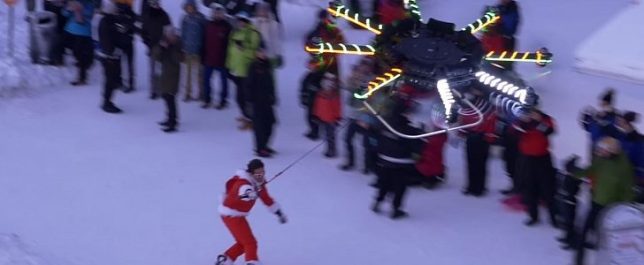If you are a photographer, you probably heard that the camera doesn’t take a good picture, the person behind the camera does. It’s true because with right knowledge and practice you can take great photos with an entry level camera or even a mobile camera. But if you don’t have an idea about lighting, composition or the features of your camera, the world’s most advanced camera can’t take good photos for you.

But when it comes to some special equipment, this phrase sometimes doesn’t apply. One piece of such equipment is called the MIOPS Smart Camera Trigger. This high-speed photography trigger can take photos at a precise moment which just impossible doing your own.
The trigger has various modes like lightning, sound, laser, time-lapse, scenario and DIY that can help you to take some outstanding images which you may have seen only on the internet previously. It can trigger your camera or fire the flashes and you can control everything using your smartphone.
So, let’s see what we can do using this wonderful high-speed trigger.
1. Popping Balloons

When you burst a water-filled balloon, the water inside the balloon makes a shape similar to the balloon for a few moments before it falls on the ground. It happens so fast that you can’t see it happening live but you can capture it using your camera.
The MIOPS Smart Trigger has a sound mode for this kind of photography. As soon as you pop the balloon, it will trigger your camera or flash. You can change the sensitivity so it doesn’t trigger with other sounds and it also gives you the option to set a delay time for triggering so that it clicks at the exact moment you want.
The sound mode can be used to photograph bursting balloons in different ways. For example, you can place sunglasses or a hat on a water-filled balloon, burst it, and capture the shape of the water wearing a hat and glasses. Or you can burst a balloon with an arrow or a dart, fill the balloons with different colored water, and take different shots and merge the images into one. The possibilities are endless.
2. Lightning

Lightning is the most beautiful natural phenomena. But it’s extremely difficult to photograph because you have no idea of when and where it will strike and chances of missing the moment are very high.
MIOPS Smart Trigger has a lightning mode for this scenario. All you need to do is set your camera on a tripod, attach this trigger, start lightning mode and leave your camera. When lightning strikes, it will trigger the camera automatically and capture that beautiful moment.
3. Paint Sculptures

You can create amazing paint sculptures and satisfy for your artistic soul with the help of this sound trigger. Do do this, you need to put a rubber sheet on a speaker, put some watercolors on it and play sound. The sound will generate vibrations on the rubber sheet and because of that paint will jump up and make different shapes.
With the help of sound mode of the MIOPS Smart Trigger, you can focus on creating different sculptures by experimenting with quantity, density, and placement of colors. Thus you leave the tough job of clicking at the perfect moment to the MIOPS.
4. Dancing Colors

It’s just like paint sculptures, but you can use dry colors instead of watercolors and create totally different results.
5. Water Droplet Refraction

Imagine capturing our Earth or even the entire universe inside a drop of water. Yes, it is possible.
MIOPS Smart Trigger has a laser mode that can help you to take such pictures in the easiest way. All you need to do is create a setup to release water drops and place a picture in the background that you want to capture inside the drop. When the drop comes in front of the camera and breaks the laser beam, the camera will capture it automatically.
6. Water Galaxy

When you spin a water-soaked ball, the water comes out from the ball and creates a beautiful galaxy shape which looks amazing.
You can capture this moment by using the laser mode of MIOPS Smart once again. When the ball comes between the trigger and the laser, the camera will shoot automatically.
7. Collision in Mid-air

Imagine a scenario where two glasses filled with colored water or paint collide in mid-air and create a beautiful splash. MIOPS Smart Trigger’s sound mode helps you to take such pictures, as seen above.
8. Action Sports Photography

You can capture high-speed action sports like a cyclist in mid-air or someone jumping on a skateboard with the help of the laser mode of this trigger. It’s very useful when you are performing the action yourself and shooting it too. Just set the MIOPS Smart Trigger to laser mode and start doing actions and leave the rest to the MIOPS.
Finally
You can also photograph birds or insects using laser mode. Just set the laser near the bird feeder and when a bird will come for feeding, the camera will capture it. Also, you can shoot fireworks with the lightning mode. The possibilities are endless, you just need to use your imagination.
In addition to this, MIOPS Smart also works as intervalometer in time-lapse mode and clicks images on a set interval to convert to time-lapse videos. Using HDR mode you can capture bracketed images and merge them into HDR. You can check the MIOPS Smart User Manual to learn more about the MIOPS Smart Trigger.
Disclaimer: MIOPS is a paid partner of dPS.
The post 8 Amazing Photography Tricks You Can Do With a High-Speed Camera Trigger by Ramakant Sharda appeared first on Digital Photography School.


















































































You must be logged in to post a comment.